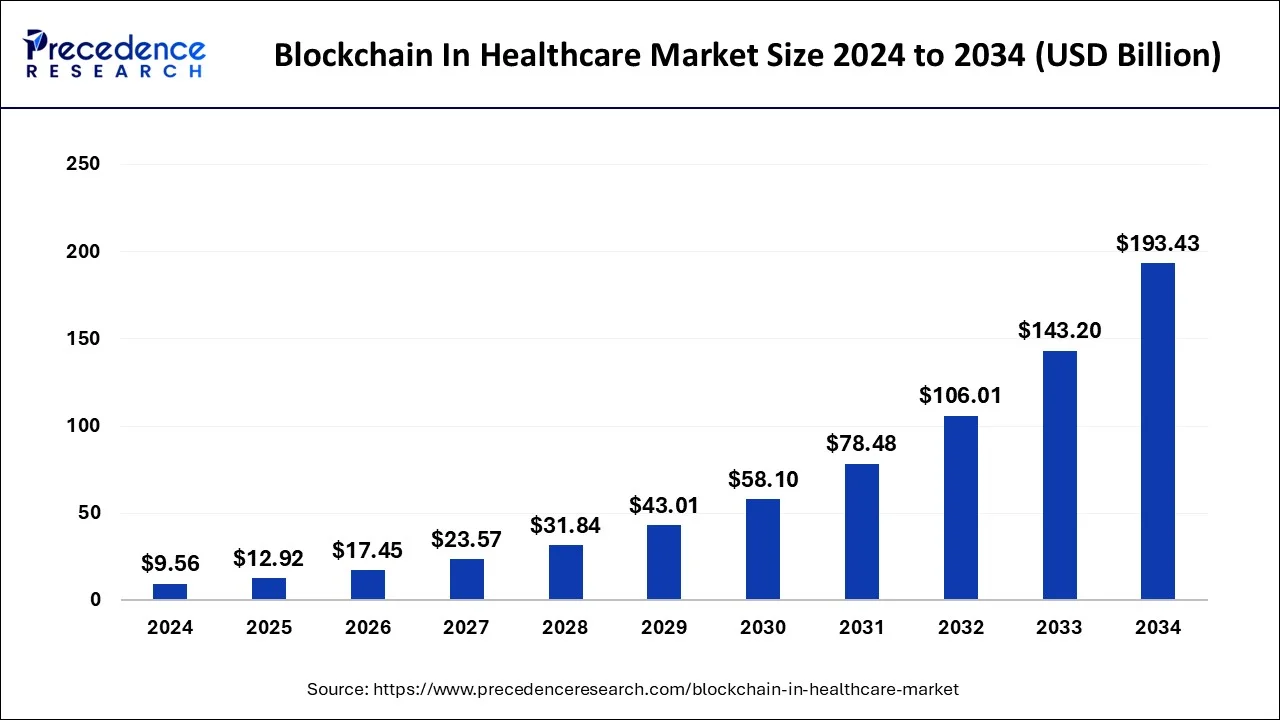Unlocking the Power of Blockchain In Healthcare: Key Notes for 2025
The healthcare industry is undergoing a digital transformation, with blockchain technology emerging as a key enabler. As we look toward 2025, blockchain is poised to revolutionize how healthcare data is managed, shared, and secured. This article will explore the market landscape of blockchain in healthcare, trending applications, its benefits and challenges, and how healthcare businesses can choose the right blockchain solution to match their needs.
A Market Overview Of Applying Blockchain In Healthcare
The healthcare industry is rapidly embracing blockchain technology as a solution to address key challenges like data security, transparency, and operational inefficiencies. The market for blockchain in healthcare is projected to grow significantly, from $1.1 billion in 2021 to $5.7 billion by 2026, at a CAGR of 39.7%. A significant driver for this growth is the increasing concern over data security, with 91% of healthcare organizations prioritizing it as a key benefit of blockchain.

Image source: Precedence Research
The adoption of blockchain is accelerating, with 40% of healthcare organizations either implementing or planning to implement blockchain in the near future. Blockchain has the potential to save the healthcare industry up to $100 billion annually by reducing administrative costs and fraud. Additionally, 74% of healthcare executives believe blockchain can solve interoperability issues by enabling secure data sharing across systems.
As regulations like HIPAA and GDPR impose stricter data privacy and security requirements, blockchain’s transparency, encryption, and immutability make it an ideal solution for compliance. In summary, blockchain is rapidly gaining traction in healthcare, offering substantial benefits in terms of security, efficiency, and cost savings while ensuring compliance with global regulations.
Discover Trending Applications of Blockchain in Healthcare
Blockchain in healthcare has a lot of potentials for extending beyond just patient data management. Below are some of the key areas where blockchain is making waves in the healthcare industry.

Image Source: Quytech
Patient Record Management
One of the most prominent applications of blockchain in healthcare is the management of patient records. Healthcare organizations often struggle with fragmented patient data stored in different silos. Blockchain offers a unified solution by creating a single, secure, and immutable record of a patient’s medical history. This decentralized approach ensures that patients’ information is accessible only to authorized parties, maintaining data privacy while improving collaboration between healthcare providers.
By using blockchain, healthcare providers can access up-to-date patient information, no matter where the patient has received care. This eliminates the risk of incomplete or outdated medical histories and improves the quality of care.
Supply Chain Transparency
The healthcare industry is reliant on a complex global supply chain to deliver medicines, medical devices, and other critical supplies. Unfortunately, the lack of transparency in this supply chain can lead to issues such as counterfeit drugs, delayed shipments, and fraud.
Blockchain can track the entire journey of pharmaceutical products, from production to distribution, ensuring that medical products are legitimate, safe, and compliant with regulations. This application is particularly valuable in addressing the issue of counterfeit drugs, which are a significant problem worldwide. By recording every transaction on a blockchain, stakeholders can easily verify the authenticity and origin of the products they receive.
Clinical Trials and Research
Clinical trials are an essential part of healthcare research, but they are often fraught with issues related to data integrity, fraud, and transparency. Blockchain provides a solution by creating a tamper-proof record of trial data. This ensures that all research findings are genuine, verifiable, and transparent to both regulators and the public.
Additionally, blockchain can help streamline the clinical trial process by securely storing patient consent records, trial protocols, and monitoring data. It enables real-time tracking and management of trial data, reducing administrative overhead and ensuring regulatory compliance.
Smart Contracts for Healthcare Services
Blockchain-powered smart contracts are transforming the way healthcare providers manage transactions and payments. These self-executing contracts automatically execute when certain conditions are met. For example, insurance claims can be processed automatically once a claim’s terms and conditions are verified, reducing delays and administrative costs.
Smart contracts can also be used in other areas of healthcare, such as automating agreements between providers, patients, and insurers. This application helps reduce errors, speed up processes, and ensure that all parties adhere to the terms of their agreements.
What Are Benefits and Challenges for Applying Blockchain in Healthcare?
Blockchain in healthcare offers transformative potentials, particularly by addressing critical issues such as data security, transparency, and operational inefficiencies. However, like any emerging technology, blockchain comes with its own set of challenges that healthcare organizations must overcome to fully reap its rewards. This section will explore both the benefits and challenges associated with implementing blockchain in healthcare, providing a comprehensive overview of how this technology can reshape the sector while also highlighting areas that need careful consideration.
Benefits of Applying Blockchain in Healthcare Sector
The application of blockchain in healthcare holds a wide range of benefits, particularly when it comes to ensuring secure, efficient, and transparent healthcare systems.

Image Source: Zeeve
- Data Security and Privacy: One of the most compelling advantages of blockchain in healthcare is its ability to improve data security and privacy. Blockchain’s decentralized nature ensures that patient data is stored in an encrypted, immutable ledger, making it virtually impossible for unauthorized parties to alter or access sensitive medical information. This level of security is critical in the healthcare sector, where data breaches can have severe consequences for both patients and healthcare providers. Blockchain’s encryption protocols also enable patients to control who accesses their information, ensuring that only authorized individuals can view or update medical records.
- Transparency and Accountability: Blockchain’s transparent nature ensures that all data transactions are traceable and verifiable. In healthcare, this feature can significantly reduce fraud and errors. For example, when managing pharmaceutical supply chains or conducting clinical trials, blockchain allows stakeholders to track the entire process in real-time, ensuring the accuracy and integrity of the data. This transparency builds trust with patients, regulators, and other stakeholders by providing verifiable proof of compliance with regulations and standards.
- Efficiency and Cost Reduction: The healthcare industry is notorious for its complex administrative processes, including billing, insurance claims, and patient record management. Blockchain helps streamline these operations by automating processes and eliminating the need for intermediaries. By enabling real-time access to medical records and reducing paperwork, blockchain can cut down on administrative costs, making healthcare services more affordable. Moreover, smart contracts, which automatically execute agreements when predefined conditions are met, can help automate insurance claims and reduce the administrative burden associated with claims processing.
- Improved Collaboration: Blockchain can also foster better collaboration between healthcare providers, patients, insurance companies, and other stakeholders. By securely sharing patient data across different organizations and platforms, blockchain facilitates real-time communication and coordination, which is crucial for providing integrated care. This improved collaboration can lead to better patient outcomes, as healthcare providers have access to a complete and up-to-date picture of a patient’s medical history.
Challenges of Applying Blockchain in Healthcare Sector
While blockchain in healthcare offers immense potential, there are several challenges that healthcare organizations must navigate to implement the technology successfully.
![ᐉ⭐ Blockchain in Healthcare: [6 Real Use Cases Included]](https://acropolium.com/img/articles/blockchain-technology-in-healthcare/img07.jpg)
Image Source: Cropolium
- Scalability Issues: One of the key challenges of implementing blockchain in healthcare is scalability. The healthcare sector generates vast amounts of data daily, and blockchain’s current infrastructure may struggle to process such a large volume of transactions efficiently. Blockchain networks can experience slower transaction speeds and higher costs when handling large-scale data. This scalability issue needs to be addressed before blockchain can be effectively adopted by healthcare systems on a global scale.
- Regulatory and Compliance Barriers: Solutions for blockchain in healthcare must comply with strict regulations, including HIPAA in the U.S. and GDPR in Europe. These regulations are designed to protect patient privacy and ensure that healthcare providers adhere to certain standards of data handling. Blockchain, being a decentralized system, may present challenges in ensuring compliance with these laws, particularly regarding data sovereignty and cross-border data flows. Healthcare organizations must ensure that the blockchain solutions they implement can meet the regulatory requirements specific to their location and sector.
- Integration with Existing Systems: Healthcare organizations often rely on legacy systems that may not be compatible with blockchain technology. Integrating blockchain with existing Electronic Health Record (EHR) systems, patient management platforms, and insurance claim systems can be complex and costly. A smooth integration process is essential to avoid disruptions to day-to-day operations. Healthcare providers must ensure that the blockchain solution they choose is compatible with their current IT infrastructure and can be easily integrated into existing workflows.
- Resource Constraints for Rare Languages and Skills: Implementing blockchain in healthcare requires skilled professionals who understand both blockchain technology and the unique needs of the healthcare sector. However, the shortage of blockchain experts in the healthcare industry may slow down adoption. Additionally, healthcare organizations may face challenges when developing blockchain solutions for specific use cases, especially when working with less common languages or in regions with limited access to resources.
Blockchain in Healthcare: How to Select the Right Solution to Match Your Needs
As the adoption of blockchain in healthcare grows, healthcare organizations must carefully evaluate their specific needs before selecting a blockchain solution. Here are a few key considerations when choosing the right blockchain solution:
- Understand Your Use Case: Different blockchain solutions are suited to different use cases. For instance, if your organization is focused on patient data management, you’ll need a blockchain solution that prioritizes data privacy and interoperability. On the other hand, if your focus is on improving supply chain transparency, you’ll want a solution that emphasizes real-time tracking and tamper-proof records.
- Choose Between Private and Public Blockchains: Blockchain solutions come in two primary forms: private and public. A private blockchain offers greater control and privacy, which can be crucial in a regulated industry like healthcare. A public blockchain, on the other hand, is more decentralized and can provide higher levels of transparency. Depending on your organization’s goals and the sensitivity of the data being managed, you’ll need to choose the blockchain type that best suits your needs.
- Consider Scalability and Flexibility: As your healthcare organization grows, so will your data management needs. It’s important to select a blockchain solution that can scale as your business expands. Look for a solution that can adapt to future technological advancements and handle an increasing volume of transactions and data.
- Evaluate Integration with Existing Systems: A blockchain solution should integrate seamlessly with your existing healthcare IT infrastructure. Make sure the blockchain platform you choose is compatible with your current systems, such as Electronic Health Records (EHR), billing platforms, and supply chain management tools.
____
In summary, blockchain in healthcare is transforming the industry by enhancing data security, transparency, and efficiency. Despite challenges like scalability and regulatory compliance, the benefits of blockchain such as secure data sharing and cost reduction, which are undeniable. As adoption grows, healthcare businesses can leverage blockchain to improve patient care and streamline operations. Savvycom’s expertise in blockchain development ensures that healthcare organizations can successfully integrate blockchain solutions tailored to their needs. In particular, we have successes in delivering many blockchain projects such as Jio Health and Eva Diary. Recently, we also played a part in the creation of Consentium – the first blockchain-based crypto wallet and community app that reward for user engagement.
If you want to unlock the power of blockchain for your healthcare business. Contact us today to explore how our tailored solutions can help you lead the digital transformation in healthcare.
Savvycom – Your Trusted Tech Partner!
Leveraging over 25 years of expertise, Savvycom has utilized digital technology to facilitate the growth of businesses spanning diverse industries. Our offerings range from top-notch technology consulting and comprehensive product development to software development consultancy, all aimed at optimizing your business potential. This underscores our commitment to delivering exceptional software outsourcing services tailored to your needs.
Savvycom is what you need. Contact us now for more consultation:
- Phone: +84 24 3202 9222
- Hotline: +84 352 287 866 (VN)
- Email: [email protected]


